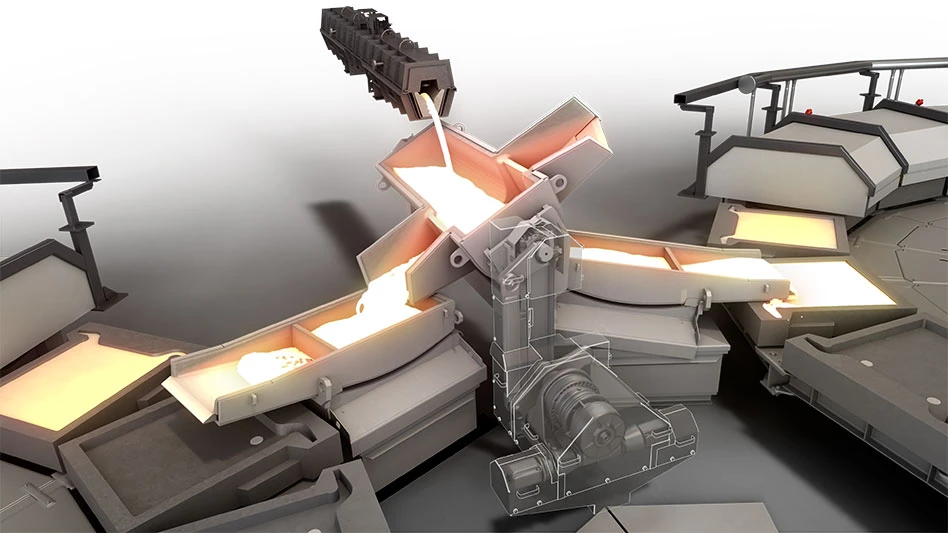Throughout the past two years, buyers, processors and shippers of ferrous scrap have been involved in the market equivalent of a high-speed chase.
Demand for ferrous scrap has hit an all-time high as the North American economy has enjoyed several strong years in a row at the same time that the People’s Republic of China has quickly constructed a steel industry that is the world’s leading producer and consumer of finished steel.
Both buyers and shippers of ferrous scrap are anxious to find out whether per-ton pricing in the $250 range will continue into 2007 or whether a downward drift in pricing is likelier.
As always, forecasting remains a dangerous game, and several scenarios and outcomes appear possible to those trying to predict how the ferrous scrap market will behave next year.
BALANCING ACT. When a commodity soars in price, economists will quickly point out that the primary reason is because demand is exceeding supply.
In the ferrous scrap boom, demand has come from both a healthy steel industry in the United States as well as the surging economy of China. Even though most of China’s steelmaking uses less-scrap-dependent basic oxygen furnaces, since the nation is now making more than 300 million tons per year, even if it using scrap as just 15 percent of its feedstock, that represents some 45 million tons of demand.
During its initial build-up, China’s steelmakers were almost entirely dependent on foreign sources of scrap. As its manufacturing sectors have strengthened and evolved, however, it is starting to generate more scrap than it did in the early part of this decade.
China working its way closer to a scrap balance is one of the scenarios that has some industry observers predicting a cooling pricing scenario for ferrous scrap. U.S. Department of Commerce volume figures for 2006 have indicated a slowing market for scrap exports to China, and dealers believe the numbers are accurate.
"We see a general softening in the export market," notes Allan Goldstein of AMG Resources, Pittsburgh. He notes that the export demand is by no means going away and adds that "foreign buyers are also getting smarter," so they are not paying per-ton prices well above the market average in the rest of the world.
By dollar amount (if not necessarily by the same volume), the U.S. exporters have been earning less for their shipments to China so far in 2006. With figures complete through August, the Commerce Department has reported a $481 million drop in the value of steelmaking materials shipped from the United States to China compared to the first eight months of 2006—an 11.2 percent decrease in value.
A look at the overall "Metal Ores and Scrap" category for the Commerce Department shows an even greater year-to-year change. The $6.95 billion shipped in the first eight months of 2006 represents a 31.3 percent decrease in sales for ores and scrap sold compared to the same period in 2005.
A partial-year comparison by no means signals a trend, but certainly after several years of gain upon gain in these categories, the final 2006 figures could indicate that China’s secondary commodities deficit is narrowing.
On the sell side, it always remains helpful to have allies, says Don Zulanch, executive vice president of Cohen Brothers Inc., Middletown, Ohio. "If we want to sell every ton every month, we can; that’s why it’s good to have relationships," he comments. "Even when the transaction is not 100 percent good for either party, we still maintain that relationship and that tonnage commitment, and that’s important to both sides."
THE HOME FRONT. Despite the massive presence in the ferrous scrap market that China now has, the fortunes and behaviors of North American steelmakers remain critical to the pricing of ferrous scrap for dealers in the United States.
For the past several years, mills with full order books operating at healthy capacity utilization rates have kept the demand for scrap strong.
There are signs, however, that many of these mills and steelmakers are beginning to take a breather. There could be several reasons for this, with fingers pointed toward fewer and smaller automobiles being purchased; a slowing housing market (and thus a slowing appliance market); and a more consolidated mill sector that is willing to cut back production when its profit margins are threatened.
On the automotive side, when gasoline prices started hitting $2 per gallon in 2005, analysts began closely monitoring passenger vehicle sales to see whether Americans would begin to lose their fervor for SUVs and large pickup trucks.
Recent sales figures demonstrate either that consumers are trading in for smaller cars or, at the very least, they are turning their backs on some of the large American models that fueled several good years for steelmakers who supply General Motors, Ford and DaimlerChrysler.
In North America, Ford Motor Co. has reported red ink in eight of the last nine quarters, and the company’s problems are possibly the most severe.
According to Bloomberg News, Ford’s U.S. auto sales dropped 17 percent in the quarter ending Sept. 30, with its profitable large pickup trucks and sport utility vehicles reporting even larger drops. "F-Series truck sales fell 25 percent, while sales of the Explorer sport utility vehicle dropped 23 percent," according to Bloomberg.
The company apparently does not see a sudden rebound and has announced it will scale back production by 21 percent in the fourth quarter of 2006. Bloomberg reports this as the largest production cutback in more than 20 years.
Fewer (and smaller) vehicles means less steel sheet being consumed, regionally if not nationally. "I think the flat-roll steelmakers are going to suffer," says Rob Bakotich, vice president of sales and marketing for Ferrous Processing & Trading Co., Detroit.
Bakotich notes that the domestic auto industry "has been on an exceptional run" for the last six to eight years. But, "the trend line does not always go up," he remarks. In his operating region, the auto industry is causing a slowdown in industrial scrap flow that can be seasonal, but it could be "more severe and earlier" than in previous years. "I hope it’s a short-term thing, not a long-term thing."
| Sorting Out Solutions |
|
Incoming flows are the lifeblood of scrap recyclers, but there is seldom one key economic condition that dictates how strong or weak those flows are. For ferrous scrap recyclers who concentrate on clean industrial scrap, the health of the manufacturing sector (especially automotive and appliances) can provide a direct correlation. But for those with a variety of equipment and with shredders in particular, several economic sectors can supply the inbound material. To make matters more complicated, the same sectors can be in widely different states of health depending on the geographic region. Among the scrap sources to be considered and how they are faring: • Industrial scrap: "Business is okay, but I think the low-lying fruit is gone," says a recycler in the Southeast, indicating a lack of new generators. • Demolition scrap: "Because of the high prices for scrap and because of general business conditions, property owners have been able to tear down and rebuild," says Rob Bakotich of FPT in Detroit. • Obsolete scrap: "There is always post-consumer scrap being generated," Bakotich says of the old automobiles and appliances that feed America’s shredders. He remarks, though, that "in certain pockets, I think we’ve cleaned up some backlogs of material, like car bodies out in fields." |
Another economic sector that concerns steelmakers and their scrap suppliers is the residential housing market—where new homes generally mean new metals-intensive appliances that go along with them.
Much like the domestic auto industry, this market has been booming for several years. And as Bakotich says of the auto industry, the trend line cannot always go up.
Many economists, however, are holding out hope for a soft landing for the housing market, and the phrase "close to hitting bottom" was used in a Business Week analysis in October.
Worrisome signs include a rising inventory of unsold existing homes that is dragging down the pricing of new homes as well. In the Western United States, some 22.8 percent fewer existing single-family homes have sold in the first eight months of 2006 compared to the same period in 2005.
New housing starts are falling to match, with Census Bureau figures indicating some 17 percent fewer new home permits were issued in September 2006 vs. September 2005.
But for steelmakers, two other economic sectors—highway spending and commercial construction—are helping provide continued demand for some of their products.
While the housing market has cooled in 2006, commercial construction spending is up by 7 percent, according to McGraw-Hill Construction, Lexington, Mass. Spending on structures ranging from hotels (up 119 percent year-to-date) to schools (up 13 percent) has helped put new steel beams and plates into place.
The infrastructure segment (highways, bridges, utilities) is also up 4 percent for the year, providing favorable demand for not only steel beams and plates, but also for reinforcing bar.
MIXED FEELINGS. Scrap processors and traders asked for predictions have one thing in common: They know better than to be confident in any of their forecasts.
"Get your dart board out," says Bakotich. "We’re asked to give forecasts, and we do reluctantly, and they’re seldom right," he comments.
"I don’t know what’s going to happen," says one Texas recycler. "I have heard there are some holes in the order books (at mills), which would tend to suggest softer markets," he ventures.
Some processors are expressing concerns that business conditions are not so much threatened by a steel industry slowdown on the sell side, but rather by an excess of competition on the buy side, particularly in the form of additional shredding capacity.
"Margins are being squeezed on the obsolete side," says one processor in the Carolinas. "There is a lot more capacity out there—too many shredders installed, and larger ones as well. In five years you’ll see some of them shut down," he predicts.
Says the Texas scrap recycler, "Good grief, they’re putting in these gargantuan shredders. I don’t what they’re gobbling up."
What consensus there is seems to indicate a softer market, but not a plunge into late 1990s’ pricing. "I think it will be good year in 2007, not a great year," says Zulanch. As far as prices falling below $100 per ton for prime grades, Zulanch says, "That seems very unlikely, [but] anything’s possible."
Bakotich agrees. "I don’t have [prime grades] trading that low, but anything is possible," he says.
While hoping against any sudden drop in the market, veteran recyclers also know they have been operating in extraordinary conditions the last couple of years.
"Most days we’re all so busy here, and everyone I talk to in this industry hardly has time to talk any more," says the Texas recycler. "Pricing may be down from its biggest peak, but that’s this month. Next month, it could go right back up."
The author is editor of Recycling Today and can be contacted at btaylor@gie.net.
Get curated news on YOUR industry.
Enter your email to receive our newsletters.

Explore the November 2006 Issue
Check out more from this issue and find your next story to read.
Latest from Recycling Today
- Fenix Parts acquires Assured Auto Parts
- PTR appoints new VP of independent hauler sales
- Updated: Grede to close Alabama foundry
- Leadpoint VP of recycling retires
- Study looks at potential impact of chemical recycling on global plastic pollution
- Foreign Pollution Fee Act addresses unfair trade practices of nonmarket economies
- GFL opens new MRF in Edmonton, Alberta
- MTM Critical Metals secures supply agreement with Dynamic Lifecycle Innovations






